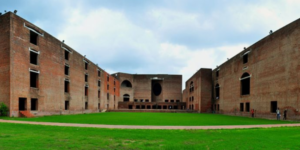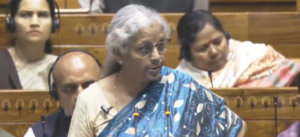❈ ❈ ❈
MP: Ahead of Polls, Congress Promises Monthly Stipend for 92 Lakh Govt School Students to Curb Dropouts
Kashif Kakvi
Bhopal: The Congress has promised to implement the ‘Padho-Padhao Yojana’ [Learn and Teach Scheme], offering school children a stipend between Rs 500 to Rs 1,500 to curb the school dropout rates in poll-bound Madhya Pradesh.
At a Congress rally in tribal-dominated Mandla, Congress leader Priyanka Gandhi Vadra promised to implement the scheme if voted to power. “Under the scheme [for government schools], the education of children from classes I to XII will be free of cost, and children from classes I to VIII will receive Rs 500 every month, those in classes IX and X will receive Rs 1,000 per month, and students in classes XI and XII will receive Rs 1,500 per month,” she said, reaching out to parents, women voters, as well as 22 lakh first-time voters in the state.
Madhya Pradesh, which has 92.45 lakh government school students up to class 12, according to the department’s 2022-23 yearly report, has recorded a dropout rate of 9%-10% in 2021-22 at the middle and senior secondary levels, according to the Union Ministry of Education report.
According to the school education department, there are a total of 90,180 government schools in Madhya Pradesh, including 59,048 primary and 3,690 higher secondary schools.
Table: Estimate of expenses on the scheme proposed by Congress
If implemented, the scheme will increase the burden on the government’s coffers by Rs 7,776 crore per annum.
“This is the first time any political party has made announcements keeping school students in mind even though they are not direct voters,” said a Congress Manifesto committee member, BK Botham. “Our aim is to educate the marginalised, not just minting votes,” he said.
According to the 2011 census, scheduled tribes, scheduled castes, and minorities account for 48% of the state’s population. The majority of drop-out students belong to these three categories, according to the reports. Students drop out for three reasons: to earn a livelihood, can’t afford a costly education, and girl students being forced to marry after they are 17 years of age.
The Ministry of Education department’s reply in Parliament over the number of ‘out-of-school children’ in February 2023 further sheds light on the abysmal condition of school education in the state. In response to Rajya Sabha MP Bikash Ranjan Bhattacharya’s question, the Ministry of Education replied that 18,667 students were out of school at the elementary level in Madhya Pradesh, while 84,788 are out of school at the secondary level — the highest in the country.
“The 18-year regime of the BJP government did little for government school education. The infrastructure is in a dilapidated state, the teachers are on the streets protesting for their rightful demands rather than in classrooms. Corruption in mid-day meals, school dress, and books led to dropouts and forced the government to close over 15,000 schools in the state in the last two decades. On the other hand, private schools are booming,” said Botham.
“For a better future for the state, we need to spend more on government schools where children of the marginalised class get an education,” he added.
When asked about the BJP government’s ambitious plan of opening 9,000 schools, announced in 2021-22, with facilities on par with private schools, Botham said, “The government closed over 15,000 schools in the last two decades, but just before the election, the announcement to open 9,000 schools isn’t going to help. They have done nothing but rename the model school to CM Rise School.”
According to Madhya Pradesh School Education Department’s yearly report, when the budget of the school education department was Rs 2,119 crore in 2008-09, there were 1.35 crore students up to standard XII in government schools. While in private schools, the number of students was 58.34 lakhs.
But after 14 years, in 2021-22, when the state education department budget saw a 10-fold jump to 24,960.49 crores, the number of students dropped to 92 lakhs from 1.35 crores.
Between 2008 and 2021, when the Madhya Pradesh government schools saw a drop of 43 lakh students in the school, the private schools saw a jump of 3.48 lakh students.
“This scheme will prevent students from becoming child labourers, and the monthly stipend will motivate marginalised parents to send their children to the schools,” said Congress spokesperson Anand Jaat.
Commenting on the proposed scheme, Ajay Gangwar, a retired IAS officer who has served at the School Education Department for a long time, pointed out that just offering a monthly stipend will not improve the dropout figures in government schools or the quality of education. “We need to understand why parents fight for the admission of their children in private schools. The obvious reply is: the quality of education. Similarly, the government needs to improve the quality of education in the schools.”
He said that the quality of education improves with functional infrastructure, qualified teachers, distance from political activities, and extracurricular activities that enhance students’ personality and knowledge – the way Kendriya Vidyalaya and Navodaya Schools have been working. “Without improving the quality of education in government schools, offering stipends will not help,” he added.
“When a 15-year-old boy can earn Rs 250 a day as a labourer, why would he come to government school for Rs 500 a month if he did not get a quality education?” asked Gangwar.
Assembly Data
According to Assembly data tabled in March this year, out of 90,180 schools, at least 6,610 government schools were without toilets, and 2,700 didn’t have washrooms for girls. A whopping 50,417 primary and middle schools in MP didn’t have boundary walls.
On a query from Congress MLA Kunal Choudhary over the basic facilities at government schools, the school education minister, Indar Singh Parmar, said, “Of the 58,506 primary schools, 2,025 don’t have girls’ toilets. It’s the same for 679 of the 24,733 middle schools. Over 3,900 schools don’t have toilets for boys either. As many as 65% of primary schools and 49% of middle schools are without a boundary wall.”
(Courtesy: Newsclick.)
❈ ❈ ❈
Gruha Lakshmi: Despite Flak, Karnataka Cash Transfer Scheme is a Powerful Tool to Empower Women
Divya Pradeep
The Karnataka government launched the Gruha Lakshmi scheme last month, fulfilling one of its significant pre-poll promises. This unconditional cash transfer programme would provide women heads of households Rs 2,000 in their bank accounts every month. The state government claims it to be the largest cash transfer scheme in the country introduced across 5,5000 panchayats in the state with a coverage of 1.9 crore women, who are already enrolled for the scheme. The Gruha Lakshmi scheme comes close on the heels of other social protection schemes introduced by the newly elected Congress government in Karnataka.
The opposition Bharatiya Janata Party (BJP) asserts that the implementation of these schemes will make the state bankrupt. This is not the first time that the Union government has expressed its disapproval of welfare schemes involving the transfer of money or free goods. Dubbing welfare schemes as “revadi culture”, or in other words, ‘freebies’, is a disguised attack by Prime Minister Narendra Modi, time and again, against BJP’s political opponents in various states. However, the allegations of fiscal imprudence does not stand the test of objectivity.
For instance, despite the implementation of several welfare measures by the Aam Aadmi Party (AAP) government in Delhi, it has been shown that for the period 2013-14 to 2017-18, there was a reduction in the percentage of public debt to the Gross State Domestic Product (GSDP) from 7.23% to 4.89% respectively.
Notwithstanding the uncritical political slandering by the Union government, an argument can be made that an objective and nuanced understanding of the social objectives behind cash transfers is needed, especially when they are targeted towards a particular sub-section such as women. This should be done in the light of context-specific realities of women in Karnataka, embedded in a socio-political and cultural context.
The analyses in the subsequent paragraphs will illuminate why affirmative action through cash transfers is a viable redistributive strategy and the specific role that cash transfers could play in women’s lives in terms of reducing physical violence and empowering them.
Cash transfers as a tool for affirmative action
A concern that has been raised in policy circles regarding cash transfers is that it may be a step towards state withdrawal from many essential services such as food, nutrition, health, and education. However, in the context of the recently introduced welfare schemes by the Karnataka government, cash transfers through Gruha Lakshmi scheme is supplemented with in-kind distribution of commodities and services. For instance, the Sakthi scheme provides free transport to all women, irrespective of their economic class, to travel in non-premium state buses and the Gruha Jyoti scheme provides up to 200 units of free power to households in Karnataka.
Cash transfers to women can also be justified on the grounds of social injustices and economic marginalisation faced by women. The Global Gender Gap Report 2023 shows that, in the criteria ‘Economic Participation and Opportunity’ (includes indicators like labour-force participation rate, wage equality for similar work, earned income etc.), India has achieved only 36.7% gender parity.
Historically, improvement in women’s labour force participation has been linked to a decrease in their unpaid domestic and care work or when such work is made more compatible with market work. However, evidence suggests a highly unequal distribution of unpaid domestic work between men and women, with women spending 7.2 hours on such work when compared to only 2.8 hours spent by men in a day, thwarting attempts by women to engage in paid work.
In light of such evidence, cash transfers can alleviate the distress of economic insecurity faced by women and should be considered as a viable affirmative remedy. Besides, such transfers to women are also a way of creating discourse in the community that there is nothing ‘natural’ about the work that women do in the private sphere of the family and that housework also deserves recognition.
Cash transfers and women’s labour force participation
It is feared that unconditional cash transfers to women will re-enforce gender stereotypes and keep women away from seeking paid employment and further entrench them in household work but such concerns are often misplaced.
The Initiative for What Works to Advance Women and Girls in the Economy (IWWAGE) shows that Karnataka has the highest rate of female labour force participation (LFPR) in India. A small transfer of Rs 2,000 is unlikely to have any significant impact on their incentives to work. A disaggregated analysis of the distribution of women workers in Karnataka by status of employment reveals that a majority of rural women are engaged in self-employment and casual labour. Around 67% of self-employed women are working only as unpaid workers in family enterprises in rural areas.
For the urban employed women, regular salaried jobs were most common but nearly 62% of such jobs were without any written job contract pointing to the precarity of such jobs. Women are also more prone to job losses and less likely to fall back on new employment arrangements during economic shocks, as was observed during COVID-19. Hence, cash transfers can be a supplementary source of income to women as many are involved in non-paying, low-paying and precarious jobs.
Cash transfers and domestic violence against women
It has also been reported that cash transfers to women have reduced intimate partner violence (IPV) against women. The evidence seems to suggest the critical role of poverty and economic insecurity as triggering factors for domestic violence.
In Karnataka, 44% of married women have experienced spousal violence as per the National Family Health Survey-5 (NFHS) report for Karnataka. It is the highest among Indian states. The state has also witnessed the highest increase in domestic violence from the previous NFHS-4 round. This paints a grim picture of gender-based violence in the state. If cash transfers help to reduce domestic violence as suggested in several studies, it would be a huge step forward towards gender justice.
Cash transfers as pathways to women empowerment
An important indicator to understand women’s empowerment, among several others, is household decision-making, ranging from what to cook, when to take a child to a health centre, to major purchase decisions in the household. Women are economically empowered only if they have control over the use of resources. However, restrictive gender norms and household dynamics often come in the way.
A study by Yale University analysing the empowerment effects, in the context of the rights-based employment guarantee programme (MGNREGA), showed that direct deposits of wages into women’s accounts had a positive impact in shaping liberal attitudes towards work and in their engagement with paid work. Gruha Lakshmi scheme is designed in a way that women directly receive the money into their Aadhar-linked bank accounts, thus, enabling them to have greater control over the use of resources.
It is also important to recognise the potential role of cash transfers in empowering women in Karnataka, especially at a time when the state has regressed on this front. There is a drop in the percentage of ever married women who participate in household decisions (including health care for oneself, making major household purchases and visits to family or relatives) from 82.7% to 80.4% and Karnataka is one of the worst-performing states.
Between NFHS-4 and NFHS-5, there is a huge drop in the percentage of women who engaged in any form of paid work from 37% to 29%. However, women having mobile phones they themselves use increased from 47.1% to 61.8%. This may augur well for the successful implementation of the Gruha Lakshmi scheme, provided adequate financial and digital literacy is provided to women to operate their mobile-linked bank accounts.
On the whole, the Congress government’s welfare scheme Gruha Lakshmi is a welcome step. It can be seen as the recognition of women’s contributions and the hope is that the financial support would improve their economic position, enable them to make household decisions and participate in public life. However, this comes with a caveat. It is not enough that cash reaches the bank accounts of women; the financial infrastructure of the state should ensure easy accessibility. As was reported during the COVID-19 pandemic, there can be rejections while accessing payments with no clear reason, necessitating multiple visits to banks. Such glitches should be avoided given that Indian women are faced with time poverty.
(Divya Pradeep teaches Economics at CHRIST (Deemed to be University), Bangalore. Courtesy: The Wire.)




